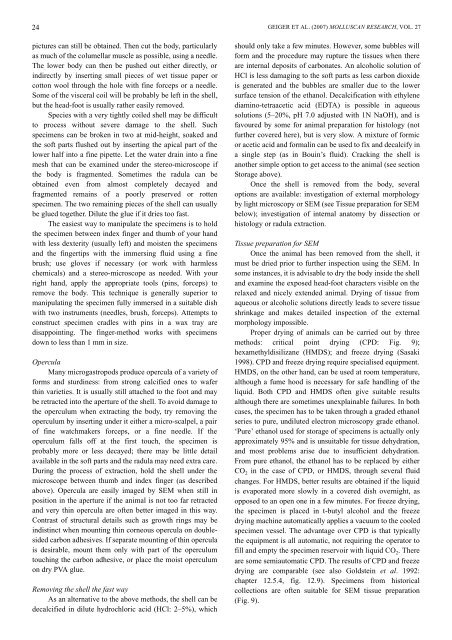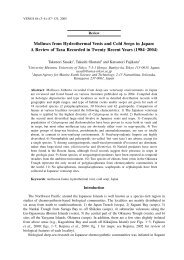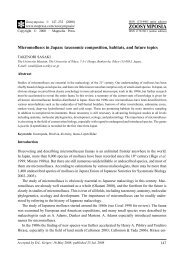Molluscan Research: Techniques for collecting, handling, preparing ...
Molluscan Research: Techniques for collecting, handling, preparing ...
Molluscan Research: Techniques for collecting, handling, preparing ...
Create successful ePaper yourself
Turn your PDF publications into a flip-book with our unique Google optimized e-Paper software.
24<br />
pictures can still be obtained. Then cut the body, particularly<br />
as much of the columellar muscle as possible, using a needle.<br />
The lower body can then be pushed out either directly, or<br />
indirectly by inserting small pieces of wet tissue paper or<br />
cotton wool through the hole with fine <strong>for</strong>ceps or a needle.<br />
Some of the visceral coil will be probably be left in the shell,<br />
but the head-foot is usually rather easily removed.<br />
Species with a very tightly coiled shell may be difficult<br />
to process without severe damage to the shell. Such<br />
specimens can be broken in two at mid-height, soaked and<br />
the soft parts flushed out by inserting the apical part of the<br />
lower half into a fine pipette. Let the water drain into a fine<br />
mesh that can be examined under the stereo-microscope if<br />
the body is fragmented. Sometimes the radula can be<br />
obtained even from almost completely decayed and<br />
fragmented remains of a poorly preserved or rotten<br />
specimen. The two remaining pieces of the shell can usually<br />
be glued together. Dilute the glue if it dries too fast.<br />
The easiest way to manipulate the specimens is to hold<br />
the specimen between index finger and thumb of your hand<br />
with less dexterity (usually left) and moisten the specimens<br />
and the fingertips with the immersing fluid using a fine<br />
brush; use gloves if necessary (or work with harmless<br />
chemicals) and a stereo-microscope as needed. With your<br />
right hand, apply the appropriate tools (pins, <strong>for</strong>ceps) to<br />
remove the body. This technique is generally superior to<br />
manipulating the specimen fully immersed in a suitable dish<br />
with two instruments (needles, brush, <strong>for</strong>ceps). Attempts to<br />
construct specimen cradles with pins in a wax tray are<br />
disappointing. The finger-method works with specimens<br />
down to less than 1 mm in size.<br />
Opercula<br />
Many microgastropods produce opercula of a variety of<br />
<strong>for</strong>ms and sturdiness: from strong calcified ones to wafer<br />
thin varieties. It is usually still attached to the foot and may<br />
be retracted into the aperture of the shell. To avoid damage to<br />
the operculum when extracting the body, try removing the<br />
operculum by inserting under it either a micro-scalpel, a pair<br />
of fine watchmakers <strong>for</strong>ceps, or a fine needle. If the<br />
operculum falls off at the first touch, the specimen is<br />
probably more or less decayed; there may be little detail<br />
available in the soft parts and the radula may need extra care.<br />
During the process of extraction, hold the shell under the<br />
microscope between thumb and index finger (as described<br />
above). Opercula are easily imaged by SEM when still in<br />
position in the aperture if the animal is not too far retracted<br />
and very thin opercula are often better imaged in this way.<br />
Contrast of structural details such as growth rings may be<br />
indistinct when mounting thin corneous opercula on doublesided<br />
carbon adhesives. If separate mounting of thin opercula<br />
is desirable, mount them only with part of the operculum<br />
touching the carbon adhesive, or place the moist operculum<br />
on dry PVA glue.<br />
Removing the shell the fast way<br />
As an alternative to the above methods, the shell can be<br />
decalcified in dilute hydrochloric acid (HCl: 2–5%), which<br />
GEIGER ET AL. (2007) MOLLUSCAN RESEARCH, VOL. 27<br />
should only take a few minutes. However, some bubbles will<br />
<strong>for</strong>m and the procedure may rupture the tissues when there<br />
are internal deposits of carbonates. An alcoholic solution of<br />
HCl is less damaging to the soft parts as less carbon dioxide<br />
is generated and the bubbles are smaller due to the lower<br />
surface tension of the ethanol. Decalcification with ethylene<br />
diamino-tetraacetic acid (EDTA) is possible in aqueous<br />
solutions (5–20%, pH 7.0 adjusted with 1N NaOH), and is<br />
favoured by some <strong>for</strong> animal preparation <strong>for</strong> histology (not<br />
further covered here), but is very slow. A mixture of <strong>for</strong>mic<br />
or acetic acid and <strong>for</strong>malin can be used to fix and decalcify in<br />
a single step (as in Bouin’s fluid). Cracking the shell is<br />
another simple option to get access to the animal (see section<br />
Storage above).<br />
Once the shell is removed from the body, several<br />
options are available: investigation of external morphology<br />
by light microscopy or SEM (see Tissue preparation <strong>for</strong> SEM<br />
below); investigation of internal anatomy by dissection or<br />
histology or radula extraction.<br />
Tissue preparation <strong>for</strong> SEM<br />
Once the animal has been removed from the shell, it<br />
must be dried prior to further inspection using the SEM. In<br />
some instances, it is advisable to dry the body inside the shell<br />
and examine the exposed head-foot characters visible on the<br />
relaxed and nicely extended animal. Drying of tissue from<br />
aqueous or alcoholic solutions directly leads to severe tissue<br />
shrinkage and makes detailed inspection of the external<br />
morphology impossible.<br />
Proper drying of animals can be carried out by three<br />
methods: critical point drying (CPD: Fig. 9);<br />
hexamethyldisilizane (HMDS); and freeze drying (Sasaki<br />
1998). CPD and freeze drying require specialised equipment.<br />
HMDS, on the other hand, can be used at room temperature,<br />
although a fume hood is necessary <strong>for</strong> safe <strong>handling</strong> of the<br />
liquid. Both CPD and HMDS often give suitable results<br />
although there are sometimes unexplainable failures. In both<br />
cases, the specimen has to be taken through a graded ethanol<br />
series to pure, undiluted electron microscopy grade ethanol.<br />
‘Pure’ ethanol used <strong>for</strong> storage of specimens is actually only<br />
approximately 95% and is unsuitable <strong>for</strong> tissue dehydration,<br />
and most problems arise due to insufficient dehydration.<br />
From pure ethanol, the ethanol has to be replaced by either<br />
CO 2 in the case of CPD, or HMDS, through several fluid<br />
changes. For HMDS, better results are obtained if the liquid<br />
is evaporated more slowly in a covered dish overnight, as<br />
opposed to an open one in a few minutes. For freeze drying,<br />
the specimen is placed in t-butyl alcohol and the freeze<br />
drying machine automatically applies a vacuum to the cooled<br />
specimen vessel. The advantage over CPD is that typically<br />
the equipment is all automatic, not requiring the operator to<br />
fill and empty the specimen reservoir with liquid CO 2 . There<br />
are some semiautomatic CPD. The results of CPD and freeze<br />
drying are comparable (see also Goldstein et al. 1992:<br />
chapter 12.5.4, fig. 12.9). Specimens from historical<br />
collections are often suitable <strong>for</strong> SEM tissue preparation<br />
(Fig. 9).




